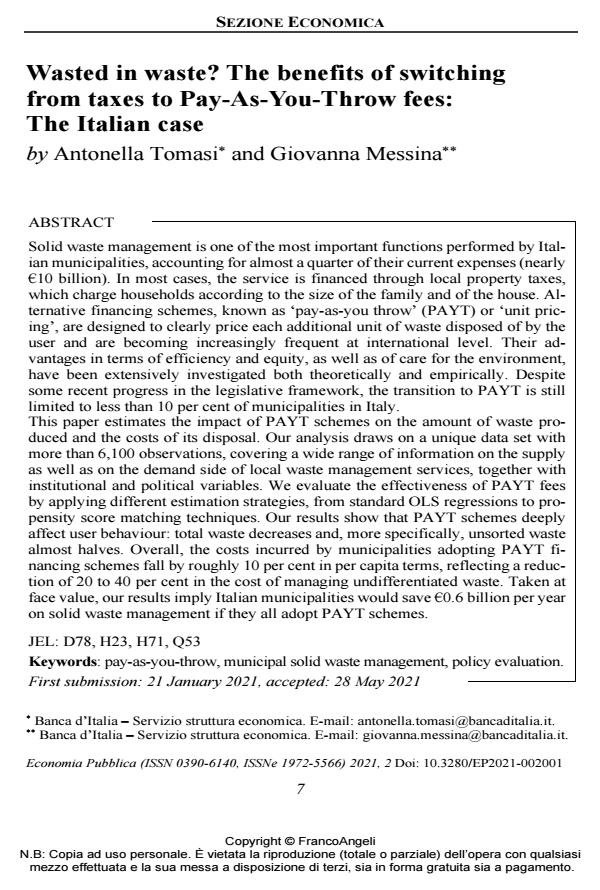Wasted in waste? The benefits of switching from taxes to Pay-As-You-Throw fees: The Italian case
Titolo Rivista ECONOMIA PUBBLICA
Autori/Curatori Antonella Tomasi, Giovanna Messina
Anno di pubblicazione 2021 Fascicolo 2021/2
Lingua Inglese Numero pagine 32 P. 7-38 Dimensione file 484 KB
DOI 10.3280/EP2021-002001
Il DOI è il codice a barre della proprietà intellettuale: per saperne di più
clicca qui
Qui sotto puoi vedere in anteprima la prima pagina di questo articolo.
Se questo articolo ti interessa, lo puoi acquistare (e scaricare in formato pdf) seguendo le facili indicazioni per acquistare il download credit. Acquista Download Credits per scaricare questo Articolo in formato PDF

FrancoAngeli è membro della Publishers International Linking Association, Inc (PILA)associazione indipendente e non profit per facilitare (attraverso i servizi tecnologici implementati da CrossRef.org) l’accesso degli studiosi ai contenuti digitali nelle pubblicazioni professionali e scientifiche
Solid waste management is one of the most important functions performed by Italian municipalities, accounting for almost a quarter of their current expenses (nearly €10 billion). In most cases, the service is financed through local property taxes, which charge households according to the size of the family and of the house. Alternative financing schemes, known as ‘pay-as-you throw’ (PAYT) or ‘unit pricing’, are designed to clearly price each additional unit of waste disposed of by the user and are becoming increasingly frequent at international level. Their advantages in terms of efficiency and equity, as well as of care for the environment, have been extensively investigated both theoretically and empirically. Despite some recent progress in the legislative framework, the transition to PAYT is still limited to less than 10 per cent of municipalities in Italy. This paper estimates the impact of PAYT schemes on the amount of waste produced and the costs of its disposal. Our analysis draws on a unique data set with more than 6,100 observations, covering a wide range of information on the supply as well as on the demand side of local waste management services, together with institutional and political variables. We evaluate the effectiveness of PAYT fees by applying different estimation strategies, from standard OLS regressions to propensity score matching techniques. Our results show that PAYT schemes deeply affect user behaviour: total waste decreases and, more specifically, unsorted waste almost halves. Overall, the costs incurred by municipalities adopting PAYT financing schemes fall by roughly 10 per cent in per capita terms, reflecting a reduction of 20 to 40 per cent in the cost of managing undifferentiated waste. Taken at face value, our results imply Italian municipalities would save €0.6 billion per year on solid waste management if they all adopt PAYT schemes.
Parole chiave:pay-as-you-throw, municipal solid waste management, policy evaluation. First submission: 21 January 2021, accepted: 28 May 2021
Jel codes:D78, H23, H71, Q53
Antonella Tomasi, Giovanna Messina, Wasted in waste? The benefits of switching from taxes to Pay-As-You-Throw fees: The Italian case in "ECONOMIA PUBBLICA " 2/2021, pp 7-38, DOI: 10.3280/EP2021-002001